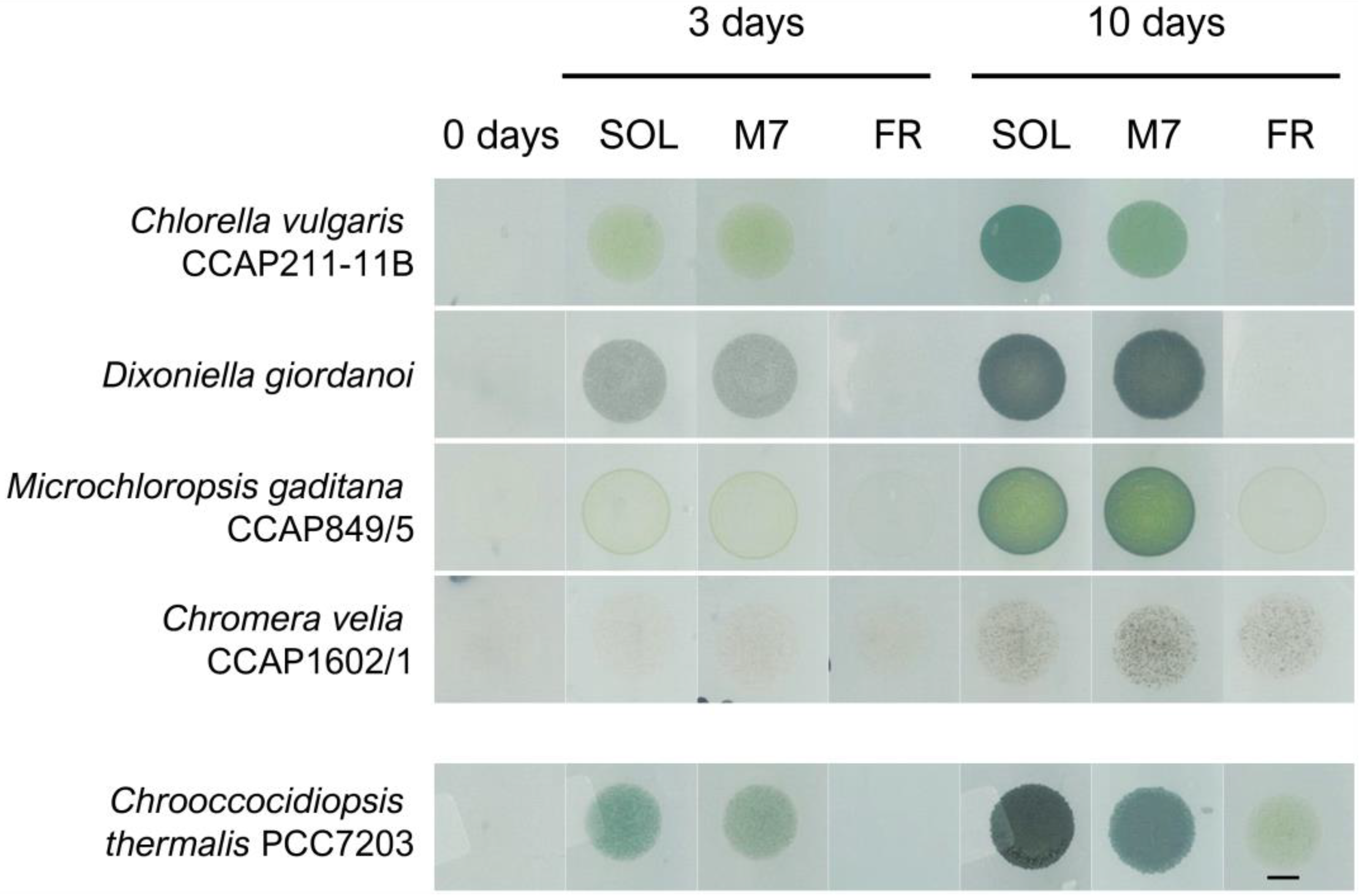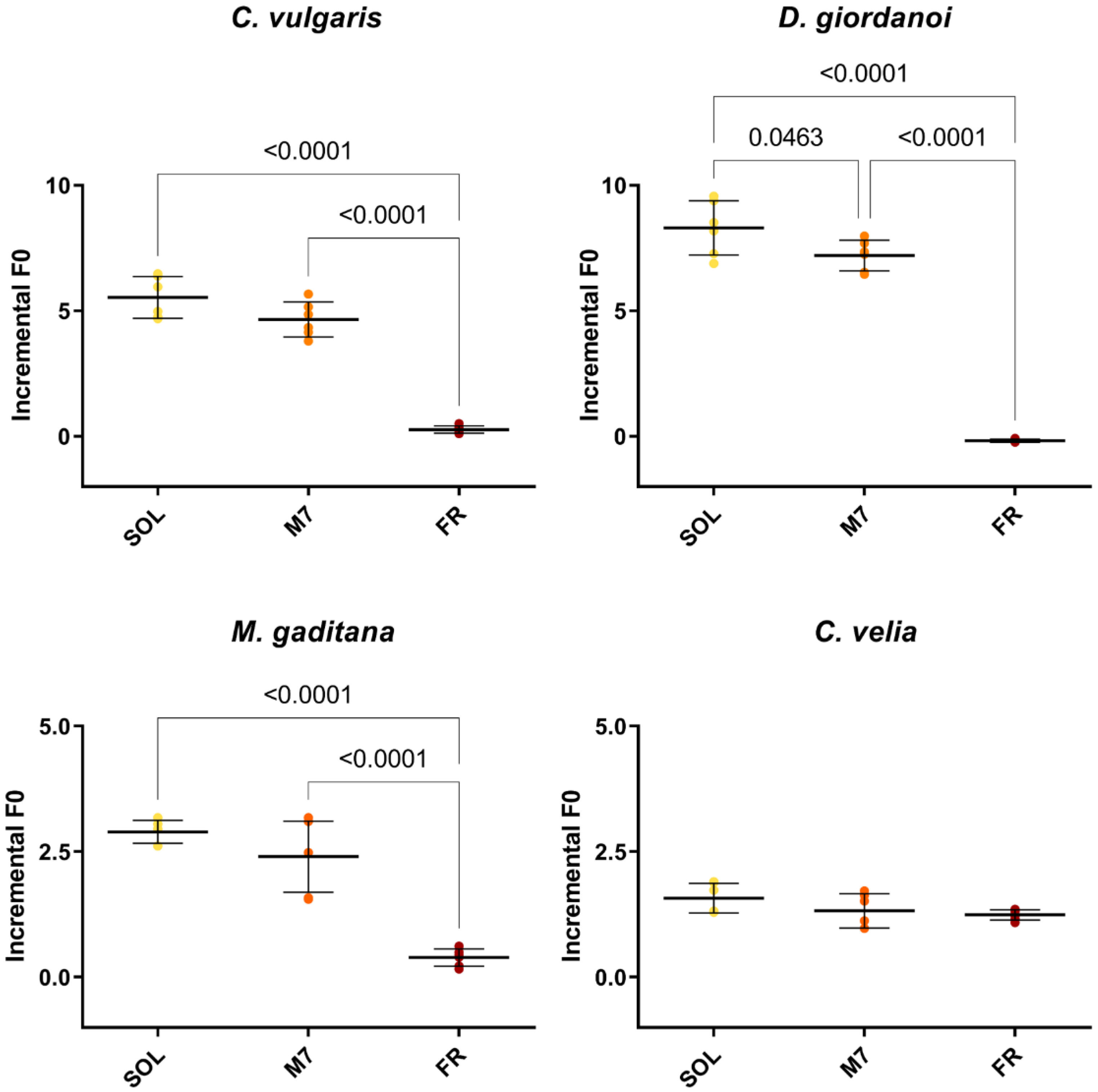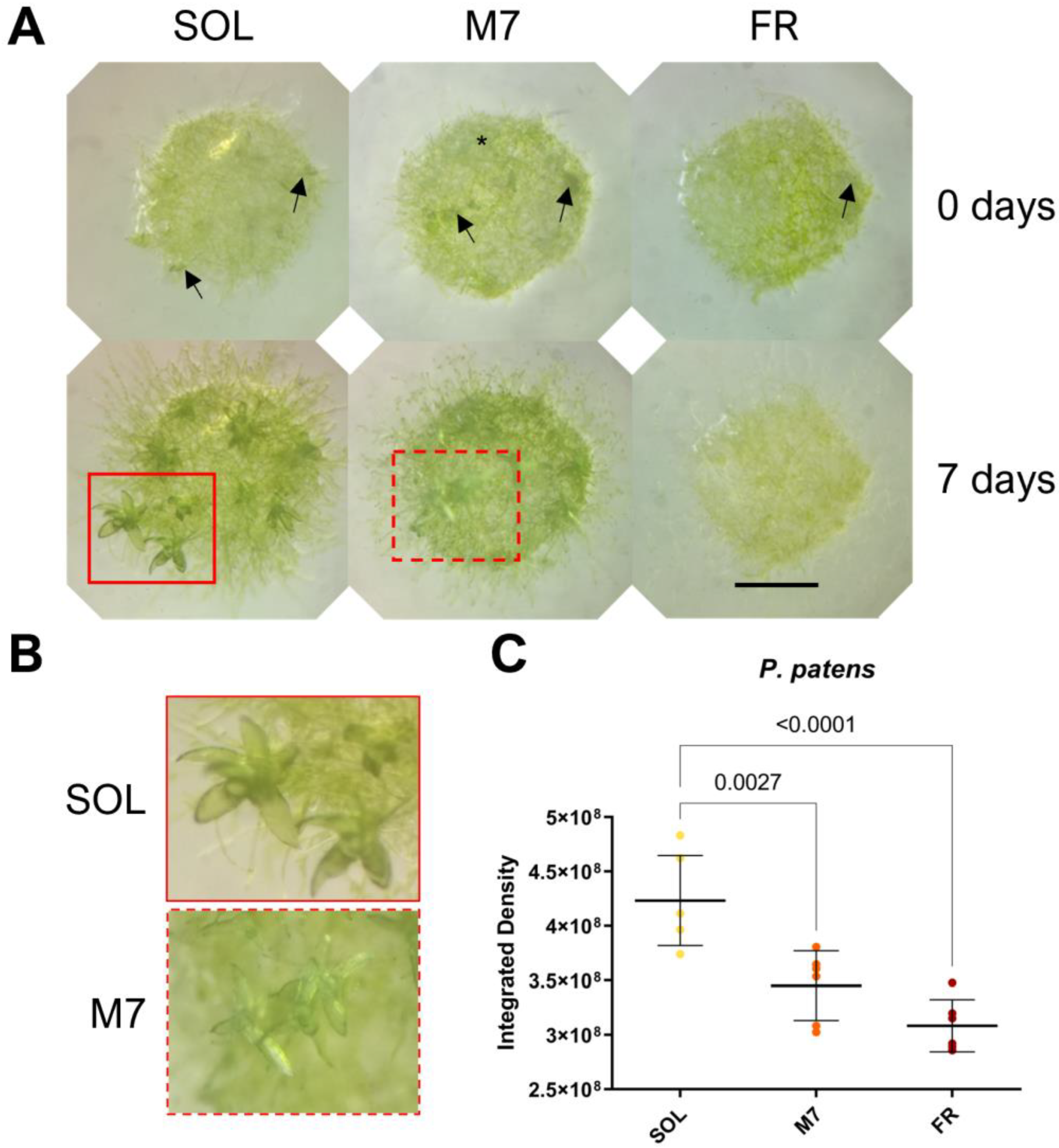Growth and Photosynthetic Efficiency of Microalgae and Plants with Different Levels of Complexity Exposed to a Simulated M-Dwarf Starlight
Abstract
1. Introduction
2. Materials and Methods
2.1. Light Conditions
2.2. Starting Biological Material
2.3. Experimental Plan
2.4. Growth Measurements
2.5. Photosynthetic Efficiency Measurements
2.6. Statistical Analyses
3. Results
3.1. Microalgal Strains Grow and Photosynthesize Similarly in M7 and SOL
3.2. Physcomitrium patens Shows Reduced Growth in M7 but Has Normal Development and Photosynthetic Efficiency
3.3. Arabidopsis thaliana rows under M7 but Shows a Shade-Avoidance Response
4. Discussion
5. Conclusions
Supplementary Materials
Author Contributions
Funding
Institutional Review Board Statement
Informed Consent Statement
Data Availability Statement
Acknowledgments
Conflicts of Interest
References
- Ricker, G.R.; Latham, D.W.; Vanderspek, R.K.; Ennico, K.A.; Bakos, G.; Brown, T.M.; Burgasser, A.J.; Charbonneau, D.; Deming, L.D.; Doty, J.P.; et al. The Transiting Exoplanet Survey Satellite (TESS). J. Astron. Telesc. Instrum. Syst. 2015, 1, 014003. [Google Scholar] [CrossRef]
- Borucki, W.J.; Koch, D.; Basri, G.; Batalha, N.; Brown, T.; Caldwell, D.; Caldwell, J.; Christensen-Dalsgaard, J.; Cochran, W.D.; DeVore, E.; et al. Kepler Planet-Detection Mission: Introduction and First Results. Science 2010, 327, 977–980. [Google Scholar] [CrossRef]
- Tinetti, G.; Encrenaz, T.; Coustenis, A. Spectroscopy of Planetary Atmospheres in Our Galaxy. Astron. Astrophys. Rev. 2013, 21, 63. [Google Scholar] [CrossRef]
- Hsu, D.C.; Ford, E.B.; Terrien, R. Occurrence Rates of Planets Orbiting M Stars: Applying ABC to Kepler DR25, Gaia DR2, and 2MASS Data. Mon. Not. R. Astron. Soc. 2020, 498, 2249–2262. [Google Scholar] [CrossRef]
- Wandel, A.; Gale, J. The Bio-Habitable Zone and Atmospheric Properties for Planets of Red Dwarfs. Int. J. Astrobiol. 2020, 19, 126–135. [Google Scholar] [CrossRef]
- Kopparapu, R.K.; Ramirez, R.; Kasting, J.F.; Eymet, V.; Robinson, T.D.; Mahadevan, S.; Terrien, R.C.; Domagal-Goldman, S.; Meadows, V.; Deshpande, R. Habitable Zones around Main-Sequence Stars: New Estimates. Astrophys. J. 2013, 765, 131. [Google Scholar] [CrossRef]
- Adams, F.C.; Laughlin, G. A Dying Universe: The Long-Term Fate and Evolutionof Astrophysical Objects. Rev. Mod. Phys. 1997, 69, 337. [Google Scholar] [CrossRef]
- Jorgensen, S.E.; Svirezhev, Y.M. Towards a Thermodynamic Theory for Ecological Systems; Elsevier: Amsterdam, The Netherlands, 2004; ISBN 0080471749. [Google Scholar]
- Schwieterman, E.W.; Kiang, N.Y.; Parenteau, M.N.; Harman, C.E.; DasSarma, S.; Fisher, T.M.; Arney, G.N.; Hartnett, H.E.; Reinhard, C.T.; Olson, S.L.; et al. Exoplanet Biosignatures: A Review of Remotely Detectable Signs of Life. Astrobiology 2018, 18, 663–708. [Google Scholar] [CrossRef]
- Kiang, N.Y.; Segura, A.; Tinetti, G.; Govindjee; Blankenship, R.E.; Cohen, M.; Siefert, J.; Crisp, D.; Meadows, V.S. Spectral Signatures of Photosynthesis. II. Coevolution with Other Stars and the Atmosphere on Extrasolar Worlds. Astrobiology 2007, 7, 252–274. [Google Scholar] [CrossRef]
- Gale, J.; Wandel, A. The Potential of Planets Orbiting Red Dwarf Stars to Support Oxygenic Photosynthesis and Complex Life. Int. J. Astrobiol. 2016, 16, 1–9. [Google Scholar] [CrossRef][Green Version]
- Takizawa, K.; Minagawa, J.; Tamura, M.; Kusakabe, N.; Narita, N. Red-Edge Position of Habitable Exoplanets around M-Dwarfs. Sci. Rep. 2017, 7, 7561. [Google Scholar] [CrossRef]
- Lehmer, O.R.; Catling, D.C.; Parenteau, M.N.; Hoehler, T.M. The Productivity of Oxygenic Photosynthesis around Cool, M Dwarf Stars. Astrophys. J. 2018, 859, 171. [Google Scholar] [CrossRef]
- Lehmer, O.R.; Catling, D.C.; Parenteau, M.N.; Kiang, N.Y.; Hoehler, T.M. The Peak Absorbance Wavelength of Photosynthetic Pigments around Other Stars from Spectral Optimization. Front. Astron. Space Sci. 2021, 8, 689441. [Google Scholar] [CrossRef]
- Lingam, M.; Loeb, A. Physical Constraints on the Likelihood of Life on Exoplanets. Int. J. Astrobiol. 2018, 17, 116–126. [Google Scholar] [CrossRef]
- Ritchie, R.J.; Larkum, A.W.D.; Ribas, I. Could Photosynthesis Function on Proxima Centauri B? Int. J. Astrobiol. 2018, 17, 147–176. [Google Scholar] [CrossRef]
- Covone, G.; Ienco, R.M.; Cacciapuoti, L.; Inno, L. Efficiency of the Oxygenic Photosynthesis on Earth-like Planets in the Habitable Zone. Mon. Not. R. Astron. Soc. 2021, 505, 3329–3335. [Google Scholar] [CrossRef]
- Lingam, M.; Balbi, A.; Mahajan, S.M. Excitation Properties of Photopigments and Their Possible Dependence on the Host Star. Astrophys. J. Lett. 2021, 921, L41. [Google Scholar] [CrossRef]
- Claudi, R.; Alei, E.; Battistuzzi, M.; Cocola, L.; Erculiani, M.S.; Pozzer, A.C.; Salasnich, B.; Simionato, D.; Squicciarini, V.; Poletto, L.; et al. Super-Earths, m Dwarfs, and Photosynthetic Organisms: Habitability in the Lab. Life 2021, 11, 10. [Google Scholar] [CrossRef]
- Battistuzzi, M.; Cocola, L.; Claudi, R.; Pozzer, A.C.; Segalla, A.; Simionato, D.; Morosinotto, T.; Poletto, L.; La Rocca, N. Oxygenic Photosynthetic Responses of Cyanobacteria Exposed under an M-Dwarf Starlight Simulator: Implications for Exoplanet’s Habitability. Front. Plant Sci. 2023, 14, 1070359. [Google Scholar] [CrossRef]
- Lyons, T.W.; Reinhard, C.T.; Planavsky, N.J. The Rise of Oxygen in Earth’s Early Ocean and Atmosphere. Nature 2014, 506, 307–315. [Google Scholar] [CrossRef]
- Gutu, A.; Kehoe, D.M. Emerging Perspectives on the Mechanisms, Regulation, and Distribution of Light Color Acclimation in Cyanobacteria. Mol. Plant 2012, 5, 1–13. [Google Scholar] [CrossRef] [PubMed]
- Antonaru, L.A.; Cardona, T.; Larkum, A.W.D.; Nürnberg, D.J. Global Distribution of a Chlorophyll f Cyanobacterial Marker. ISME J. 2020, 14, 2275–2287. [Google Scholar] [CrossRef] [PubMed]
- Gan, F.; Zhang, S.; Rockwell, N.C.; Martin, S.S.; Lagarias, J.C.; Bryant, D.A. Extensive Remodeling of a Cyanobacterial Photosynthetic Apparatus in Far-Red Light. Science 2014, 345, 1312–1317. [Google Scholar] [CrossRef] [PubMed]
- Jung, P.; Harion, F.; Wu, S.; Nürnberg, D.J.; Bellamoli, F.; Guillen, A.; Leira, M.; Lakatos, M. Dark Blue-Green: Cave-Inhabiting Cyanobacteria as a Model for Astrobiology. Front. Astron. Space Sci. 2023, 10, 1107371. [Google Scholar] [CrossRef]
- Billi, D.; Napoli, A.; Mosca, C.; Fagliarone, C.; de Carolis, R.; Balbi, A.; Scanu, M.; Selinger, V.M.; Antonaru, L.A.; Nürnberg, D.J. Identification of Far-Red Light Acclimation in an Endolithic Chroococcidiopsis Strain and Associated Genomic Features: Implications for Oxygenic Photosynthesis on Exoplanets. Front. Microbiol. 2022, 13, 933404. [Google Scholar] [CrossRef]
- Shih, P.M.; Matzke, N.J. Primary Endosymbiosis Events Date to the Later Proterozoic with Cross-Calibrated Phylogenetic Dating of Duplicated ATPase Proteins. Proc. Natl. Acad. Sci. USA 2013, 110, 12355–12360. [Google Scholar] [CrossRef]
- Dagan, T.; Roettger, M.; Stucken, K.; Landan, G.; Koch, R.; Major, P.; Gould, S.B.; Goremykin, V.V.; Rippka, R.; De Marsac, N.T.; et al. Genomes of Stigonematalean Cyanobacteria (Subsection V) and the Evolution of Oxygenic Photosynthesis from Prokaryotes to Plastids. Genome Biol. Evol. 2013, 5, 31–44. [Google Scholar] [CrossRef]
- Deusch, O.; Landan, G.; Roettger, M.; Gruenheit, N.; Kowallik, K.V.; Allen, J.F.; Martin, W.; Dagan, T. Genes of Cyanobacterial Origin in Plant Nuclear Genomes Point to a Heterocyst-Forming Plastid Ancestor. Mol. Biol. Evol. 2008, 25, 748–761. [Google Scholar] [CrossRef]
- Ligrone, R. Biological Innovations That Built the World; Springer: Berlin/Heidelberg, Germany, 2019. [Google Scholar]
- Gould, S.B.; Waller, R.F.; McFadden, G.I. Plastid Evolution. Annu. Rev. Plant Biol. 2008, 59, 491–517. [Google Scholar] [CrossRef]
- Wolf, B.M.; Blankenship, R.E. Far-Red Light Acclimation in Diverse Oxygenic Photosynthetic Organisms. Photosynth. Res. 2019, 142, 349–359. [Google Scholar] [CrossRef]
- Litvín, R.; Bína, D.; Herbstová, M.; Pazderník, M.; Kotabová, E.; Gardian, Z.; Trtílek, M.; Prášil, O.; Vácha, F. Red-Shifted Light-Harvesting System of Freshwater Eukaryotic Alga Trachydiscus Minutus (Eustigmatophyta, Stramenopila). Photosynth. Res. 2019, 142, 137–151. [Google Scholar] [CrossRef]
- Bína, D.; Gardian, Z.; Herbstová, M.; Kotabová, E.; Koník, P.; Litvín, R.; Prášil, O.; Tichý, J.; Vácha, F. Novel Type of Red-Shifted Chlorophyll a Antenna Complex from Chromera Velia: II. Biochemistry and Spectroscopy. Biochim. Biophys. Acta—Bioenergy 2014, 1837, 802–810. [Google Scholar] [CrossRef]
- Wolf, B.M.; Niedzwiedzki, D.M.; Magdaong, N.C.M.; Roth, R.; Goodenough, U.; Blankenship, R.E. Characterization of a Newly Isolated Freshwater Eustigmatophyte Alga Capable of Utilizing Far-Red Light as Its Sole Light Source. Photosynth. Res. 2018, 135, 177–189. [Google Scholar] [CrossRef] [PubMed]
- Gommers, C.M.M.; Visser, E.J.W.; Onge, K.R.S.; Voesenek, L.A.C.J.; Pierik, R. Shade Tolerance: When Growing Tall Is Not an Option. Trends Plant Sci. 2013, 18, 65–71. [Google Scholar] [CrossRef] [PubMed]
- Croce, R.; Van Amerongen, H. Light-Harvesting in Photosystem I. Photosynth. Res. 2013, 116, 153–166. [Google Scholar] [CrossRef] [PubMed]
- Zhen, S.; Haidekker, M.; van Iersel, M.W. Far-Red Light Enhances Photochemical Efficiency in a Wavelength-Dependent Manner. Physiol. Plant. 2019, 167, 21–33. [Google Scholar] [CrossRef]
- Zhen, S.; Bugbee, B. Far-Red Photons Have Equivalent Efficiency to Traditional Photosynthetic Photons: Implications for Redefining Photosynthetically Active Radiation. Plant Cell Environ. 2020, 43, 1259–1272. [Google Scholar] [CrossRef]
- Zhen, S.; van Iersel, M.W.; Bugbee, B. Photosynthesis in Sun and Shade: The Surprising Importance of Far-Red Photons. New Phytol. 2022, 236, 538–546. [Google Scholar] [CrossRef]
- Battistuzzi, M.; Cocola, L.; Salasnich, B.; Erculiani, M.S.; Alei, E.; Morosinotto, T.; Claudi, R.; Poletto, L.; La Rocca, N. A New Remote Sensing-Based System for the Monitoring and Analysis of Growth and Gas Exchange Rates of Photosynthetic Microorganisms under Simulated Non-Terrestrial Conditions. Front. Plant Sci. 2020, 11, 182. [Google Scholar] [CrossRef]
- Fattore, N.; Savio, S.; Vera-Vives, A.M.; Battistuzzi, M.; Moro, I.; La Rocca, N.; Morosinotto, T. Acclimation of Photosynthetic Apparatus in the Mesophilic Red Alga Dixoniella Giordanoi. Physiol. Plant. 2021, 173, 805–817. [Google Scholar] [CrossRef]
- Sciuto, K.; Moschin, E.; Fattore, N.; Morosinotto, T.; Moro, I. A New Cryptic Species of the Unicellular Red Algal Genus Dixoniella (Rhodellophyceae, Proteorhodophytina): Dixoniella Giordanoi. Phycologia 2021, 60, 524–531. [Google Scholar] [CrossRef]
- Oliver, M.J.; Velten, J.; Mishler, B.D. Desiccation Tolerance in Bryophytes: A Reflection of the Primitive Strategy for Plant Survival in Dehydrating Habitats? Integr. Comp. Biol. 2005, 45, 788–799. [Google Scholar] [CrossRef] [PubMed]
- Paul, A.L.; Elardo, S.M.; Ferl, R. Plants Grown in Apollo Lunar Regolith Present Stress-Associated Transcriptomes That Inform Prospects for Lunar Exploration. Commun. Biol. 2022, 5, 382. [Google Scholar] [CrossRef] [PubMed]
- Link, B.M.; Busse, J.S.; Stankovic, B. Seed-to-Seed-to-Seed Growth and Development of Arabidopsis in Microgravity. Astrobiology 2014, 14, 866–875. [Google Scholar] [CrossRef]
- Richards, J.T.; Corey, K.A.; Paul, A.-L.; Ferl, R.J.; Wheeler, R.M.; Schuerger, A.C. Exposure of Arabidopsis Thaliana to Hypobaric Environments: Implications for Low-Pressure Bioregenerative Life Support Systems for Human Exploration Missions and Terraforming on Mars. Astrobiology 2006, 6, 851–866. [Google Scholar] [CrossRef]
- Guillard, R.R.; Ryther, J.H. Studies of Marine Planktonic Diatoms. I. Cyclotella Nana Hustedt, and Detonula Confervacea (Cleve) Gran. Can. J. Microbiol. 1962, 8, 229–239. [Google Scholar] [CrossRef] [PubMed]
- Rippka, R.; Deruelles, J.; Waterbury, J.B. Generic Assignments, Strain Histories and Properties of Pure Cultures of Cyanobacteria. J. Gen. Microbiol. 1979, 111, 1–61. [Google Scholar] [CrossRef]
- Ashton, N.W.; Grimsley, N.H.; Cove, D.J. Analysis of Gametophytic Development in the Moss, Physcomitrella Patens, Using Auxin and Cytokinin Resistant Mutants. Planta 1979, 144, 427–435. [Google Scholar] [CrossRef] [PubMed]
- Storti, M.; Alboresi, A.; Gerotto, C.; Aro, E.; Finazzi, G.; Morosinotto, T. Role of Cyclic and Pseudo-cyclic Electron Transport in Response to Dynamic Light Changes in Physcomitrella Patens. Plant. Cell Environ. 2019, 42, 1590–1602. [Google Scholar] [CrossRef]
- Saavedra, L.; Balbi, V.; Lerche, J.; Mikami, K.; Heilmann, I.; Sommarin, M. PIPKs Are Essential for Rhizoid Elongation and Caulonemal Cell Development in the Moss Physcomitrella Patens. Plant J. 2011, 67, 635–647. [Google Scholar] [CrossRef]
- Seager, S.; Turner, E.L.; Schafer, J.; Ford, E.B. Vegetation’s Red Edge: A Possible Spectroscopic Biosignature of Extraterrestrial Plants. Astrobiology 2005, 5, 372–390. [Google Scholar] [CrossRef] [PubMed]
- Kiang, N.Y.; Siefert, J.; Govindjee; Blankenship, R.E. Spectral Signatures of Photosynthesis. I. Review of Earth Organisms. Astrobiology 2007, 7, 222–251. [Google Scholar] [CrossRef]
- Wandel, A. On the Biohabitability of M-Dwarf Planets. Astrophys. J. 2018, 856, 165. [Google Scholar] [CrossRef]
- Kula, M.; Rys, M.; Skoczowski, A. Far-Red Light (720 or 740 Nm) Improves Growth and Changes the Chemical Composition of Chlorella Vulgaris. Eng. Life Sci. 2014, 14, 651–657. [Google Scholar] [CrossRef]
- Kula, M.; Rys, M.; Mozdzeń, K.; Skoczowski, A. Metabolic Activity, the Chemical Composition of Biomass and Photosynthetic Activity of Chlorella Vulgaris under Different Light Spectra in Photobioreactors. Eng. Life Sci. 2014, 14, 57–67. [Google Scholar] [CrossRef]
- Emerson, R.; Chalmers, R.; Cederstrand, C. Some Factors Influencing the Long-Wave Limit of Photosynthesis. Proc. Natl. Acad. Sci. USA 1957, 43, 133–143. [Google Scholar] [CrossRef]
- Zhen, S. Substituting Far-Red for Traditionally Defined Photosynthetic Photons Results in Equal Canopy Quantum Yield for CO2 Fixation and Increased Photon Capture during Long-Term Studies: Implications for Re-Defining PAR. Front. Plant Sci. 2020, 11, 581156. [Google Scholar] [CrossRef]
- Moore, R.B.; Oborník, M.; Janouškovec, J.; Chrudimský, T.; Vancová, M.; Green, D.H.; Wright, S.W.; Davies, N.W.; Bolch, C.J.S.; Heimann, K.; et al. A Photosynthetic Alveolate Closely Related to Apicomplexan Parasites. Nature 2008, 451, 959–963. [Google Scholar] [CrossRef]
- Kotabová, E.; Jarešová, J.; Kaňa, R.; Sobotka, R.; Bína, D.; Prášil, O. Novel Type of Red-Shifted Chlorophyll a Antenna Complex from Chromera Velia. I. Physiological Relevance and Functional Connection to Photosystems. Biochim. Biophys. Acta—Bioenergy 2014, 1837, 734–743. [Google Scholar] [CrossRef]
- Wangpraseurt, D.; Larkum, A.W.D.D.; Ralph, P.J.; Kühl, M. Light Gradients and Optical Microniches in Coral Tissues. Front. Microbiol. 2012, 3, 316. [Google Scholar] [CrossRef]
- Wilhelm, C.; Jakob, T. Uphill Energy Transfer from Long-Wavelength Absorbing Chlorophylls to PS II in Ostreobium Sp. Is Functional in Carbon Assimilation. Photosynth. Res. 2006, 87, 323–329. [Google Scholar] [CrossRef]
- Herbstová, M.; Bína, D.; Koník, P.; Gardian, Z.; Vácha, F.; Litvín, R. Molecular Basis of Chromatic Adaptation in Pennate Diatom Phaeodactylum Tricornutum. Biochim. Biophys. Acta—Bioenergy 2015, 1847, 534–543. [Google Scholar] [CrossRef]
- Maberly, S.C.; Spence, D.H.N. Photosynthesis and Photorespiration in Freshwater Organisms: Amphibious Plants. Aquat. Bot. 1989, 34, 267–286. [Google Scholar] [CrossRef]
- Maberly, S.C. The Fitness of the Environments of Air and Water for Photosynthesis, Growth, Reproduction and Dispersal of Photoautotrophs: An Evolutionary and Biogeochemical Perspective. Aquat. Bot. 2014, 118, 4–13. [Google Scholar] [CrossRef]
- Spence, D.H.N.; Chrystal, J. Photosynthesis and Zonation of Freshwater Macrophytes. New Phytol. 1970, 69, 205–215. [Google Scholar] [CrossRef]
- Bierfreund, N.M.; Tintelnot, S.; Reski, R.; Decker, E.L. Loss of GH3 Function Does Not Affect Phytochrome-Mediated Development in a Moss, Physcomitrella Patens. J. Plant Physiol. 2004, 161, 823–835. [Google Scholar] [CrossRef]
- Biswal, D.P.; Panigrahi, K.C.S. Red Light and Glucose Enhance Cytokinin-Mediated Bud Initial Formation in Physcomitrium Patens. Plants 2022, 11, 707. [Google Scholar] [CrossRef]
- Franklin, K.A.; Quail, P.H. Phytochrome Functions in Arabidopsis Development. J. Exp. Bot. 2010, 61, 11–24. [Google Scholar] [CrossRef]
- Hu, C.; Nawrocki, W.J.; Croce, R. Long-Term Adaptation of Arabidopsis Thaliana to Far-Red Light. Plant Cell Environ. 2021, 44, 3002–3014. [Google Scholar] [CrossRef]
- Pierik, R.; Testerink, C. The Art of Being Flexible: How to Escape from Shade, Salt, and Drought1. Plant Physiol. 2014, 166, 5–22. [Google Scholar] [CrossRef]
- Karsten, U.; Holzinger, A. Green Algae in Alpine Biological Soil Crust Communities: Acclimation Strategies against Ultraviolet Radiation and Dehydration. Biodivers. Conserv. 2014, 23, 1845–1858. [Google Scholar] [CrossRef] [PubMed]
- de Vries, J.; Archibald, J.M. Plant Evolution: Landmarks on the Path to Terrestrial Life. New Phytol. 2018, 217, 1428–1434. [Google Scholar] [CrossRef] [PubMed]
- Gorski, C.; Riddle, R.; Toporik, H.; Da, Z.; Dobson, Z.; Williams, D.; Mazor, Y. The Structure of the Physcomitrium Patens Photosystem I Reveals a Unique Lhca2 Paralogue Replacing Lhca4. Nat. Plants 2022, 8, 307–316. [Google Scholar] [CrossRef]
- Tinetti, G.; Rashby, S.; Yung, Y.L. Detectability of Red-Edge-Shifted Vegetation on Terrestrial Planets Orbiting M Stars. Astrophys. J. Lett. 2006, 644, L129. [Google Scholar] [CrossRef]




| Organism | Fv/Fm | |
|---|---|---|
| SOL | M7 | |
| C. vulgaris | 0.61 ± 0.02 a | 0.58 ± 0.05 a |
| D. giordanoi | 0.55 ± 0.01 a | 0.55 ± 0.01 a |
| M. gaditana | 0.69 ± 0.01 a | 0.69 ± 0.01 a |
| C. velia | 0.40 ± 0.02 a | 0.45 ± 0.02 b |
| Organism | Fv/Fm | |
|---|---|---|
| SOL | M7 | |
| P. patens | 0.79 ± 0.02 a | 0.78 ± 0.04 a |
| Organism | Fv/Fm | |
|---|---|---|
| SOL | M7 | |
| A. thaliana | 0.77 ± 0.03 a | 0.75 ± 0.02 a |
Disclaimer/Publisher’s Note: The statements, opinions and data contained in all publications are solely those of the individual author(s) and contributor(s) and not of MDPI and/or the editor(s). MDPI and/or the editor(s) disclaim responsibility for any injury to people or property resulting from any ideas, methods, instructions or products referred to in the content. |
© 2023 by the authors. Licensee MDPI, Basel, Switzerland. This article is an open access article distributed under the terms and conditions of the Creative Commons Attribution (CC BY) license (https://creativecommons.org/licenses/by/4.0/).
Share and Cite
Battistuzzi, M.; Cocola, L.; Liistro, E.; Claudi, R.; Poletto, L.; La Rocca, N. Growth and Photosynthetic Efficiency of Microalgae and Plants with Different Levels of Complexity Exposed to a Simulated M-Dwarf Starlight. Life 2023, 13, 1641. https://doi.org/10.3390/life13081641
Battistuzzi M, Cocola L, Liistro E, Claudi R, Poletto L, La Rocca N. Growth and Photosynthetic Efficiency of Microalgae and Plants with Different Levels of Complexity Exposed to a Simulated M-Dwarf Starlight. Life. 2023; 13(8):1641. https://doi.org/10.3390/life13081641
Chicago/Turabian StyleBattistuzzi, Mariano, Lorenzo Cocola, Elisabetta Liistro, Riccardo Claudi, Luca Poletto, and Nicoletta La Rocca. 2023. "Growth and Photosynthetic Efficiency of Microalgae and Plants with Different Levels of Complexity Exposed to a Simulated M-Dwarf Starlight" Life 13, no. 8: 1641. https://doi.org/10.3390/life13081641
APA StyleBattistuzzi, M., Cocola, L., Liistro, E., Claudi, R., Poletto, L., & La Rocca, N. (2023). Growth and Photosynthetic Efficiency of Microalgae and Plants with Different Levels of Complexity Exposed to a Simulated M-Dwarf Starlight. Life, 13(8), 1641. https://doi.org/10.3390/life13081641







